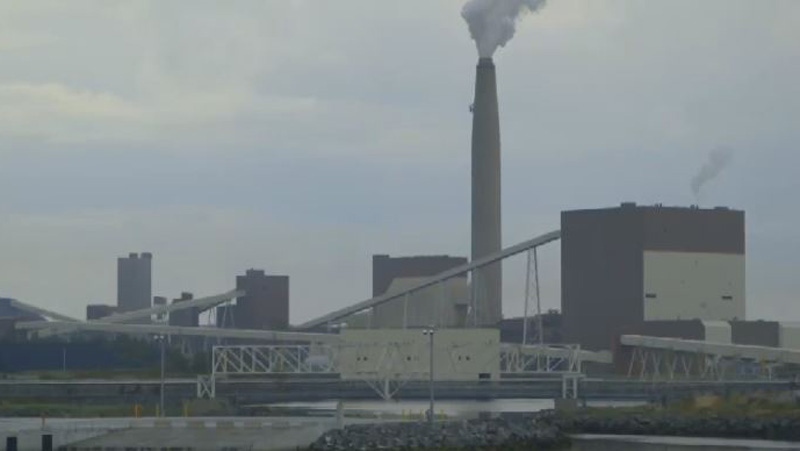N.B. coroner’s inquest shares recommendations to improve workplace safety within high-risk industries
 New Brunswick's Belledune coal-fired generating station is seen.
New Brunswick's Belledune coal-fired generating station is seen.
A coroner’s inquest into the death of Louis Gagnon has concluded, with the jury classifying his death as the result of an accident.
According to a news release from the New Brunswick government, Gagnon died on Jan. 27, 2020, “as a result of injuries sustained while working at the Belledune Generating Station.”
The inquest – which is a formal court proceeding, but does not make findings of legal responsibility or assign blame – was held from Feb. 20 to 22 at the Campbellton courthouse. The five-member jury heard from 14 witnesses.
The jury made the following recommendations for high-risk industries, aimed a preventing deaths under similar circumstances:
- That before any project begins, a competent person or competent persons should be appointed to inspect the positioning and strength of the anchors and other support equipment (both existing and newly installed) required for the project, using the appropriate tools.
- That the entry of anyone into a confined space should be announced, so that those present are informed and the person entering is added to the attendance register.
- That employers and employees ensure they have the necessary and appropriate materials to perform the assigned task in a safe environment.
- That the line of fire should be clearly marked (for example, by red tape) with a label indicating the reason for the tape and the name of the person who placed the tape and has the authority to grant permission to enter the danger zone.
- That the line of fire should be visually indicated during tailgate meetings. If the line of fire changes during the day, work should stop and a meeting should be held to identify the new line-of-fire zone.
- That there should be direct and regular verbal communication among all persons assigned to the same project and radio communication if the distance is too great to see or hear the persons concerned.
For WorkSafeNB and high-risk industries:
- That employers ensure that anyone working on rigging systems are trained by a person certified in all equipment and materials that could be used on a project and that this training is always up to date.
Additional recommendations were made by deputy chief coroner Emily Caissie, who presided over the inquest:
- That NB Power for any project either internal or contracted out, where mechanical pulling is required, requires the establishment of a pull plan completed by engineers. The pull plan should include, but not be limited to:
- Theoretical calculation and physical verification of the applied tension on any anchor points.
- What material/equipment should be used.
- How and where to install said material/equipment accompanied with visual images for the plan.
- Pull step with a checklist.
- Inspection protocols following the installation of the material/equipment prior to the start of the work.
- Establish a formal process that must be followed if any deviation to the original plan needs to be made.
“The chief coroner will forward these recommendations to the appropriate agencies for consideration and response,” reads the release.
CTVNews.ca Top Stories

Cisco reveals security breach, warns of state-sponsored spy campaign
State-sponsored actors targeted security devices used by governments around the world, according to technology firm Cisco Systems, which said the network devices are coveted intrusion points by spies.
An emergency slide falls off a Delta Air Lines plane, forcing pilots to return to JFK in New York
An emergency slide fell off a Delta Air Lines jetliner shortly after takeoff Friday from New York, and pilots who felt a vibration in the plane circled back to land safely at JFK Airport.
Last letters of pioneering climber who died on Everest reveal dark side of mountaineering
George Mallory is renowned for being one of the first British mountaineers to attempt to scale the dizzying heights of Mount Everest during the 1920s. Nearly a century later, newly digitized letters shed light on Mallory’s hopes and fears about ascending Everest.
Decoy bear used to catch man who illegally killed a grizzly, B.C. conservation officers say
A man has been handed a lengthy hunting ban and fined thousands of dollars for illegally killing a grizzly bear, B.C. conservation officers say.
opinion RFK Jr.'s presidential candidacy and its potential threat to Biden and Trump
Although it's still unclear how much damage Robert F. Kennedy Jr.'s candidacy can do to either Joe Biden or Donald Trump this election, Washington political columnist Eric Ham says what is clear is both sides recognize the potential threat.
Haida elder suing Catholic Church and priest, hopes for 'healing and reconciliation'
The lawyer for a residential school survivor leading a proposed class-action defamation lawsuit against the Catholic Church over residential schools says the court action is a last resort.
First court appearance for boy and girl charged in death of Halifax 16-year-old
A girl and a boy, both 14 years old, made their first appearance today in a Halifax courtroom, where they each face a second-degree murder charge in the stabbing death of a 16-year-old high school student.
Opinion I just don't get Taylor Swift
It's one thing to say you like Taylor Swift and her music, but don't blame CNN's AJ Willingham's when she says she just 'doesn't get' the global phenomenon.
It's 30 years since apartheid ended. South Africa's celebrations are set against growing discontent
South Africa marked 30 years since the end of apartheid and the birth of its democracy with a ceremony in the capital Saturday that included a 21-gun salute and the waving of the nation's multicolored flag.

































